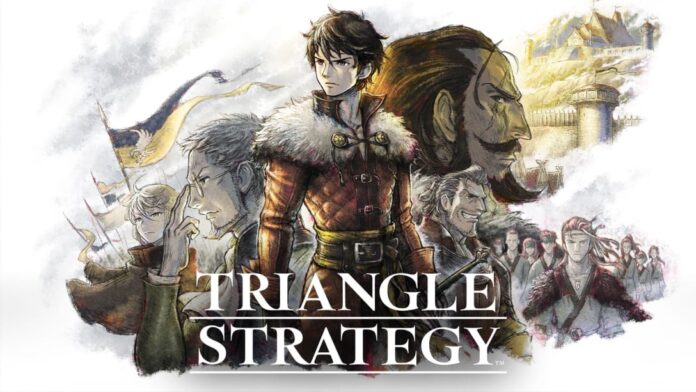After the commercial and critical success of Octopath Traveler, Square Enix has opted for somewhat of a spiritual successor. Although using the same nostalgic yet beautifully modern “HD-2D” style developed with Unreal Engine 4, Triangle Strategy is undoubtedly a standalone adventure in terms of story, as well as gameplay mechanics. While both titles are produced by Tomoya Asano, and can technically be classified as turn-based RPGs, Octopath Traveler has a menu-based battle system, comparable to early entries in the Final Fantasy and Dragon Quest series, whereas Triangle Strategy has a grid-based one, such as the likes of Fire Emblem.
Triangle Strategy was first announced during a Nintendo Direct airing in February 2021 under the working title “Project Triangle Strategy”. Despite early playful criticism across the internet that the name was far too basic and on the nose, almost as if generated by artificial intelligence, Square Enix ultimately decided to keep the title as is anyway, simply dropping “Project” from it, as they also previously did with Octopath Traveler prior to its own respective release.
A free debut demo was made available for (Project) Triangle Strategy immediately following the game’s initial reveal, allowing fans to submit feedback to the developers on how to improve the overall experience. The demo was downloaded via the Nintendo Switch eShop approximately a million times, with about 250,000 corresponding survey responses. Naturally, this led to a multitude of positive changes that found their way into the final release of the game, including; better load times, additional difficulty options, camera control adjustments, conversation logs, the ability to auto-play and skip events, and dozens more minor improvements and features.
Here’s a bit of what the producers of Triangle Strategy had to say last September in regards to the feedback received from the demo:
“Based on these survey results, users have high expectations for the game’s story, the personalities of the characters, and the system for leveling up and improving characters in tactical strategy games. These are elements you may not have been able to enjoy fully in the Debut Demo.
However, in the final version of TRIANGLE STRATEGY, you will be able to experience the events leading up to the invasion and what happens after you make specific decisions. The story will branch out in various ways, and many unique characters will enter the story. We hope you’ll look forward to it.
Lastly, our development team was very happy to receive encouraging results about purchase intent from those who responded to the survey!
We will continue to develop the game in an effort to meet your expectations. We appreciate your continued support for TRIANGLE STRATEGY.”
– Yasuaki Arai & Tomoya Asano
Having now been given the chance to play through the first three chapters of the final version of Triangle Strategy, it is abundantly clear that the developers meant what they said in all regards. An engaging story, interesting characters, and complex battle system pulls you into the game’s world right from the start. It’s also true that your decisions will indeed leave an impact on the story. You’ll often encounter three different dialog response options, each strengthening the convictions of the main character, Serenoa, with either Utility, Morality, or Liberty. Your choices will then affect behind-the-scenes elements such as which characters will join your party to fight alongside you in battles. Each of your party members also have their own convictions, which can directly change the path of the main story. When voting commences amongst them for important plot-altering decisions, it’s up to you, the player, to persuade the majority into voting for the direction you’d like to take.
The story of Triangle Strategy is told using main events and sub-events that are selectable via the world map as they are unlocked. Sub-events are optional, and are simply available to provide context and additional details to the plot. While progressing yourself through the main events, previous sub-events will vanish if not completed accordingly. Main events, rather, are how you properly progress through the game itself, and consist of three core gameplay components; story scenes, battles, and exploration. Although skippable, the story scenes, where you mostly just press the A button to continue through dialog, are the most plentiful, and are fortunately complete with full voice acting. The options for English and Japanese are easily swappable in the settings, both seemlessly offering high quality vocal performances.
As for the plot itself, your journey takes place long after what’s known as the “Saltiron War” in the continent of Norzelia, a realm made up of three great nations; The Kingdom of Glenbrook, The Grand Duchy of Aesfrost, and The Holy Slate of Hyzant, each responsible for housing a vital resource for all of the land. Even though it has been 30 years since a truce was made over the control and trade of iron and salt, and the Saltiron War has ended, the effects of battle still linger no doubt, and each nation continues to work together to bring a stronger peace, or so their intentions would seem. Serenoa, the game’s main protagonist, is appointed lord of House Wolfort in the nation of Glenbrook following the sudden illness of his father, Lord Symon. To further strengthen the bond between House Wolfort of Gelnbrook and the Grand Duchy of Aesfrost, the eldest daughter of the Aestrost family, Frederica, is set to take Serenoa’s hand in marriage. With Serenoa now lord of the second highest power in all of Norzelia, next only to the royal family, he must make future-altering decisions alongside his friends, bride-to-be, and fellow warriors.
Exploration phases spread throughout the telling of the story provide a traditional RPG experience. During these short but sweet sequences, you’ll be given the opportunity to freely traverse a designated area in order to examine your terrain to prepare for battle, visit merchants that sell unique offerings, collect items that are spread throughout the land (indicated by a tiny flashing sparkle), and chat with various characters. Talking with the NPCs during exploration is quite an important task, as it can provide you with the knowledge necessary to later convince your party members of making certain decisions that, as mentioned earlier, can completely change the course of your adventure.
Finally, the meat and potatoes of Triangle Strategy is, of course, the tactical turn-based battles. It’s kind of like playing an overly complex version of chess, with each of the pieces, known as units, having unique abilities, stats, and classes. Frederica for example, is a pyromancer, equipped with fire-based abilities and resistance to fire-based attacks. As the units within your party level-up, which is done by earning EXP when defeating opponents and winning in battles, they will receive an increase in HP and learn new abilities. At the start of every battle, you are tasked with arranging your party in your desired positions, and when on the battlefield, there is a color-coded grid that your units travel on so as to easily understand how far you can move on each turn, the range of your attacks, and the range of enemy attacks. Taking advantage of the high ground on the multileveled terrain for increased damage, striking an enemy from behind their back for a critical hit, or engaging in “Follow-Up Attacks” by placing units on both sides of an enemy, are just a few of the key ways to help crown yourself victorious. There are many more important factors to keep in mind, including elemental terrain effects, but we’ll go into further detail on the battle system in our full review set to be published at a later date.
Prior to a battle, or anytime within the menu of the world map, you’ll have access to the Encampment. Here, you can buy and sell items from a merchant, upgrade your weapons from a blacksmith (if you have the necessary materials), promote your class at the sundry shop, and participate in mock battles for training. Kudos and coins are the two main forms of currency in Norzelia, each serving different purposes. Kudos are earned by completing certain maneuvers in battle, whereas coins are gathered from victories and exploration.
Triangle Strategy is an extremely promising HD-2D successor to Octopath Traveler. First impressions show that Square Enix has greatly outdone themselves, providing a fresh RPG experience that features an interesting story, a vast cast of characters, a fleshed out battle system, and a beautiful art-style and environment. If you’re interested in trying out the game for yourself, a brand new demo that includes chapters 1-3 has launched today on the Nintendo eShop. If you’re pleased with the experience and decide to pick up the full game upon its release on 4th March 2022, you need not worry, as your save data from the demo will transfer over.
A copy of Triangle Strategy for preview purposes was provided by Nintendo UK. A full review of the game will be published in due course.
Related News
mynintendonews.com







